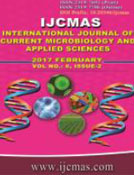


 National Academy of Agricultural Sciences (NAAS)
National Academy of Agricultural Sciences (NAAS)

|
PRINT ISSN : 2319-7692
Online ISSN : 2319-7706 Issues : 12 per year Publisher : Excellent Publishers Email : editorijcmas@gmail.com / submit@ijcmas.com Editor-in-chief: Dr.M.Prakash Index Copernicus ICV 2018: 95.39 NAAS RATING 2020: 5.38 |
A set of 27 pearl millet (Pennisetum glaucum (L.) R. Br.] ) hybrids that newly developed using A1 cytoplasmic male-sterile lines, were evaluated over three (two wet and one dry) crop seasons (hereafter refer to as environments) in Randomized Complete Block Design (RCBD) with two replications to predict genotype by environment (G × E) interaction for grain yield and its component traits, and to identify the high yielding stable hybrids through AMMI and cluster analysis method for possible adaption. Analysis of variance showed significant genetic variation for all studied traits exists. The Additive Main Effects and Multiplicative Interaction (AMMI) analysis indicated that genotype, environment and G × E interaction highly significant for grain yield and other traits. However, G × E interaction component explained very low magnitude (3.87%) towards total genetic variation, while genotype alone contributed much higher magnitude (8.04%) in AMMI model and found TNBH 05 45 was an ideal hybrid for all three environments for grain yield (34% over best control). Diversity analysis showed seven diverse clusters following Euclidean distance coefficient of 0.91 and found TNBH 05 03 and TNBH 05 45 hybrids are promising. Based on these two models, TNBH 05 03, TNBH 39 and TNBH 05 45 were identified for stable performance per se in all the environments, and could be used for subsequent advanced testing and hybrid breeding programmes for possible release within regions.
 |
 |
 |
 |
 |